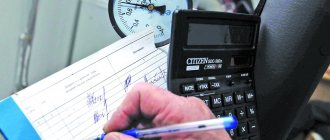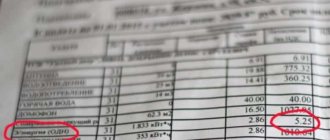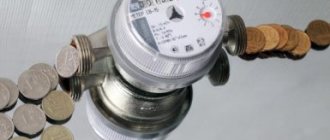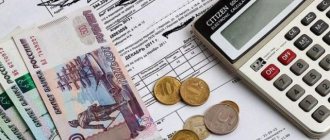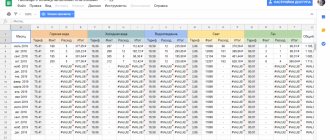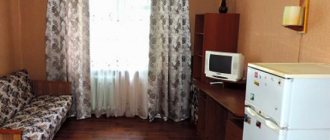What does ODN mean for electricity?
Electricity costs for general house needs (GDE) consist of several factors. This includes lighting of the local area, staircase landings, maintenance of elevator facilities, etc. All this adds up to considerable costs for MKD.
What are the standards for electricity consumption at the ODN used for settlements with the energy supply company? The fair redistribution of electricity costs between apartment owners depends on how the charging system is structured.
Previously, management companies (MCs) of apartment buildings paid for ODN with funds accumulated by subtracting amounts from utility payments of homeowners. It was practically impossible to control the correctness of the accrual of one-time income tax to each owner. Unscrupulous administrators of the management organization took advantage of this, committing fraud with funds.
Starting in 2021, new ODN standards for electricity were introduced. They were determined by calculation, which is closest to the actual electricity consumption for general household needs.
The articles of the new Federal Law (Federal Law) remove from circulation fraudulent schemes that were used to unjustifiably increase the costs of one-way electricity supply, in contrast to the real ones. Cash withdrawals were made from payments made by residents not only in the city, but also in large populated areas throughout the Russian Federation. Innovations forced management administrations to take into account strict rules for accounting, monitoring and saving electricity.
Tariffs for ODN in 2021
Standard parameters for general household needs for the population represent a discovery of information. This suggests that every resident of an apartment building can familiarize themselves with their values within the official resource of their management organization. At the same time, citizens living in their homes undertake to pay for utility bills in the manner prescribed by Russian legislation as amended (Federal Law No. 258 “On Amendments to Articles 154, 156 of the Housing Code of the Russian Federation” dated July 29 .2017 in a new edition).
The same legislative norm (Federal Law No. 258) implies that since 2017, meter readings, and not standard values, are used for settlement actions. According to this Federal Law, residents will pay for individual consumption, and in addition to this, for general household expenses. Their amount is directly proportional to the size of the apartment: the larger it is, the greater the amount withdrawn for general house expenses. In 2021, ODNs are not allocated as a separate line, however, no one has canceled the fee for them.
For your information
Standards for the consumption of resources for general household needs are usually subject to publication in the public domain. Therefore, each citizen retains the right to verify the correctness of the accrued payment, which ensures the transparency of settlement activities. In 2021, the Government approved the fact of increasing tariff estimates for the housing and communal services sector. But if we take into account the growth of the crisis, the increase in prices will occur moderately. There is an assumption that from July 1 of this year there will be an increase of 2.5-7.5%, depending on the specific region.
What is included in the ODN
What is commercial electricity metering
The structure of ODN includes all electricity costs, except for residential consumption:
- electric lighting of stairs, platforms, access vestibules and common corridors;
- light in basements and attics;
- power supply for elevator facilities;
- connection and operation of video cameras and intercoms;
- maintenance of fire alarms, pumps and other electrical equipment for public use;
- losses in household networks.
Network losses
Electricity losses in networks are considered to be the difference between the incoming volume of electric current and its recorded consumption inside the house. Losses are borne by additional payment to the electricity distribution company. Reasons causing intra-house current leakage:
- Incorrect selection of wire cross-sections causes thermal losses of electricity in the electrical wiring conductors.
- Poorly assembled contact groups of switches, lamp sockets, switches, sockets, etc.
- Operation of old electrical equipment.
Losses in networks can be reduced only by replacing old electrical wiring with new wires, the cross-section of which corresponds to the load, as well as by replacing worn-out electrical equipment with more modern devices.
Taking readings from the electric meter
Payment for one day
Electricity consumption standards per person without a meter
In addition to making payments for consumed electricity according to the readings of individual electricity meters, residents of apartment buildings bear the cost of electricity consumption. A special line ODN is included in receipt books for utility services for homeowners.
Payment for consumed electricity according to ODN for one apartment in a multi-storey building is determined by the formula:
Pi=Viodn NS,
Where:
- Viodn – the share of ODNE per apartment.
- N – standard (kWh/1m2), approved by local authorities;
- S – total area of the apartment.
Over the past few years, homeowners of some apartment buildings have begun to notice an unreasonable increase in the amount of payments for electricity bills. This is due to the fact that between the direct consumer and the supplier of electric current there is an intermediary - the management company (MC) of the MKD.
What to do about it
Now you know how one rate is calculated for electricity, cold water and heat. It is worth clearly realizing that the adopted reform is not a simple bill, but a decision that has already entered into force. Therefore, we need to adapt to changes now and benefit from them.
In fact, by reforming the payment system for public utility services, we can minimize non-targeted costs that previously arose when paying utility bills. It is clear that it takes years to fight the established mentality, but still, the transition to honesty in paying for utility services is the primary task of each of us.
And this applies not only to residents, but also to representatives of management companies. Of course, not everyone will be willing or able to follow the second path of development, choosing honesty over fraud. Our task, as consumers, is to understand the essence of what is happening and stop attempts at deception on the part of the management company. This is not so difficult to do - just carefully study the formulas for calculating payment for ODN and monthly calculate how much you have to pay to the management company. The formulas we proposed above will absolutely help with this.
Today, everyone can and should install an individual meter at home, promptly reporting its data to the management company. General automation of the transfer of meter readings remains a matter of tomorrow, but its implementation needs to be stimulated today.
The new system for calculating ODN is a reform, in the future aimed at improving the quality of service for each home and optimizing resource consumption. This opportunity is worth taking advantage of, because ultimately, by acting in this way, every owner of a home in an apartment building will be able to improve their own quality of life.
Dear readers!
It's fast and free!
Or call us by phone (24/7).
General house needs (CHN) - consumption of heat and electricity in the entrances, basement, and attic of an apartment building. In order to encourage apartment owners to save energy resources, the Russian authorities have established a fee for electricity spent on outdoor heating equipment in multi-storey buildings. Service companies have the right to charge these payments since May 2006.
Initially, for general house needs in multi-storey buildings, it was carried out strictly according to standards. This payment was an insignificant part of the fee for the use of the owners' resources. With the adoption of Russian Government Resolution No. 344 in April 2013, its accrual depends on the area of living space.
To understand how ODN for electricity is calculated, it is necessary to consider the formulas approved by the government and mandatory for use.
Standards for ODN for electricity in the regions of the Russian Federation
Introduction to peak and other electricity tariff zones
The size of the standard depends on the quality of the electrical equipment of the house and its number of floors. Standards in each region of Russia are set by local authorities. They represent a single value per 1 m2 of area, relating to communal premises and local areas.
The new rules for calculating ODNE practically exclude unauthorized increases in the amount of payment for this expense item. Previously, the management company itself made payments to the energy supply company, but now the costs of ODNE are borne by the apartment owners according to a special line in the receipt. The calculation of this expense item is based on the standard adopted by the regional state administration.
There is no uniform standard for ODNE for MKD across the country. In different territorial entities of the Russian Federation, indicators vary greatly. To calculate ODN, you need to take into account a number of factors:
- number of floors of apartment buildings;
- the presence or absence of an elevator, house electric boiler, pumps, lighting of the local area, etc.;
- whether ODPU (common house metering devices) is installed or not;
- local tariff for ODNE.
Based on these data, a standard is formed, on the basis of which LTNE is calculated in the receipt. Since the beginning of 2019, people have been paying for electricity supply according to regional standards. Now, if electricity consumption is less than the standard, then payment is made based on consumption. Below is a table of standards in some regions and republics of Russia, established by local authorities from 01.01. 2021
Table of standards for ODNE
| Regions | Standard ODN, kW/h per 1 m2 per month | |
| MKD without elevator | MKD with elevator | |
| Moskovskaya (Moscow) | 2,88 | 0,61 |
| Leningradskaya (St. Petersburg) | 1,66 | 0,42 |
| Nizhny Novgorod (Nizhny Novgorod) | 1,6 | 0,39 |
| Sverdlovskaya (Ekaterinburg) | 4,16 | 1,96 |
| Saratovskaya (Saratov) | 2,44 | 1,82 |
| Novosibirsk (Novosibirsk) | 0,973 | 0,728 |
| Lipetskaya | 1,24 | 0,37 |
| Rostovskaya (Rostov-on-Don) | 2,24 | 0,55 |
| Yaroslavskaya (Yaroslavl) | 1,01 | 0,646 |
| Republic of Crimea (Simferopol) | 0,58 | 0,21 |
| Krasnodar region (Krasnodar) | 1,412 | 0,322 |
| Republic of Bashkorstan (Ufa) | 0,791 | 0,295 |
| Republic of Adygea (Maykop) | 1,357 | 0,315 |
General house needs from 2021: calculation and features
Until this year, general house needs were recorded in a separate line of the housing and communal services receipt. Since 2021, home maintenance costs have acquired new features of calculation and accrual. To understand what a utility bill is made up of, you need to understand where the costs for public utility services are now indicated and what the essence of the changes is.
What is included in the ODN
Common house needs (CHN) are one of the expense items included in residents’ utility bills. This concept applies only to apartment buildings - in individual residential buildings there is no common housing. The ODN includes ensuring the functioning of household common areas (clause 1 of Article 36 of the Housing Code of the Russian Federation):
- lighting of attics, basements, entrances, elevators, technical rooms;
- electricity necessary for servicing antennas, pumps, operating elevators, etc.;
- heating of these areas;
- water consumption during seasonal inspections of the heating system;
- electricity and water costs for maintaining the local area: watering lawns, lighting the yard.
As previously calculated
Until 2021, the rules governing the calculation of ODN fees were quite vague.
Therefore, management companies calculated payments at their own discretion, and residents of some areas were faced with a large difference in tariffs: relatively speaking, one received a payment of 200 rubles, and another received a payment of 600.
This column in receipts provided a field for fraudulent actions by housing and communal services workers, and residents could not check whether the values indicated in their payments were correct. In 2021, a number of reforms were introduced in this area.
Changes for 2021
On January 1, 2021, changes to the Housing Code of the Russian Federation came into force, establishing a system of payment for the use of common premises according to standards. These standards had to be adopted by the authorities in each region independently, taking into account the latest changes.
But the standards were not updated in all regions, and some housing companies, taking advantage of the innovations, did not reduce the payments of their residents, but increased them. Due to numerous complaints, the Ministry of Construction in February sent letter No. 4275 dated February 14, 2017 to all heads of constituent entities with explanations.
Advice!
The letter explained that if a building has common meters installed and the actual resource consumption is less than the established standards, residents pay according to the meters. If the consumption according to the meters is higher than indicated in the standards, residents pay only a fixed amount of the norm, and the management company pays for the excess.
That is, apartment owners are not required to pay more than the norm, but have the right to reduced payments in case of saving resources.
However, this letter was of an advisory nature and was not accepted by all regions for implementation. Therefore, in the summer, the authorities adopted the law dated July 29, 2017 N 258-FZ “On amendments to Articles 154 and 156 of the Housing Code of the Russian Federation...”, which officially approved provisions on the priority of metering indicators in the formation of payments for single-use income.
Designation on the housing and communal services receipt
These changes also affected the processing of payment documents. Previously, the category of general house needs was indicated as a separate line - utilities for maintaining the house.
In 2021, accruals for one-time tax payments appear on receipts not as a single payment, which is not clearly formed from, but broken down into components included in the overall bill.
For example: in the electricity column the payment for consumption in the apartment and for consumption in the house (in the elevator, entrance, etc.) is indicated. The water bill is distributed in the same way.
How are calculations made?
Thus, the system for calculating general household needs has been approved by law since 2021. The peculiarity is that you can pay both according to standards and according to the meter.
The readings of collective meters are given priority, but residents are not required to pay for them if the readings exceed the standards. For the excess, the management company must pay extra.
The issue of choosing meter readings or standards can be decided at a meeting of apartment owners.
Please note: communal meters must be installed by the management company. As homeowners who have entered into an agreement with the management company, residents have every right to demand the installation of metering devices in the house.
The fee for one-time service is calculated as follows.
- If the house is equipped with meters , then the summarized readings of apartment expenses are subtracted from the readings of the common device. The resulting values are divided among all residents depending on the area of the apartment (in proportion to the size of the living space, the maintenance fee for the premises also increases).
- If there are no meters , the standards established by local authorities apply. The area of the total property of the house is multiplied by a unit of the accepted rate of water or electricity consumption. The received amount is divided among homeowners in proportion to the size of the apartment. You can familiarize yourself with the standards of your region on the website of the administration of the subject (region, republic) or request it from your own housing company.
Growth of payments according to standards
As a result of the revision of the standardized volumes of ODN, residents of some regions noted a significant (up to 30%) increase in costs.
"Upravdom" - an interregional committee created by United Russia to check and adjust the work of housing and communal services, in 2021 checked the established values.
In 24 subjects, general house costs for electricity turned out to be significantly higher than objective indicators, and in 9 subjects – for cold water. In this regard, the Government of the Russian Federation issued Decree No. 1498, where a directive was given to bring these standards to adequate indicators.
As a result of the adjustment, the growth of ODN for 2021, according to official data for the country, amounted to about 3-4%.
Is it possible to save money?
Equipping premises with metering devices for the benefit of residents of apartment buildings. This will save on costs. Features of calculating ODN in 2021 are the priority of meter indicators over standards.
In addition, the utility payment should not include items for servicing missing resources: if the payment includes a bill for watering the lawn or hot water, but there is no trace of a lawn in your yard, and the water in the technical rooms is cold, this is fraud.
Attention!
In a house equipped with metering devices, the actual consumption of resources becomes important. This is influenced by equipping premises with energy-saving light bulbs, motion sensors (this innovation is used in new houses), replacing electrical wiring in the entrance and timely repair of water and heating pipes - all these tasks must be performed by the management company.
Important: not everyone knows that the management company servicing the house can be changed. If the management company refuses to install metering devices and improve conditions in common premises, by decision of the meeting of owners, you can terminate the contract with the existing company and enter into a new one.
Watch a video about the new rules for calculating one-time income:
How to calculate ODNE in MKD using a meter
Homeowners in apartment buildings are often interested in how to calculate the ODN on their own. The calculation is simple. The total area of the apartment building, including communal areas and apartments, is taken as a basis. The established tariff of a specific region is entered into the calculation. The readings of the ODPU and individual electricity meters are taken into account.
If there is no communal meter in the apartment building, then the calculation is carried out according to another option. Below are examples of calculations of ODN for electricity.
Example of calculating ODN
Accrual of ODN in 2021
ODN services in 2021 are already included in your receipt. That is, they are not entered as a separate line, but are added to the total amount. Therefore, it’s time to remember that common areas include:
The receipt will include data calculated using common house metering devices (CDMU). They are installed for cold and hot water, as well as electricity and heating.
The house's needs for metering power supply are calculated simply - they represent the difference between the readings of the metering power supply and the sum of the readings of the personal meters of all residents. If the owner of the living space does not have an individual meter, the share of his ODN is distributed proportionally based on the area of the apartment.
Examples of calculating the ODN of a multi-storey building
There are two formulas for calculating how to pay for one electricity supply. One of them is an option for calculating ODN without a common house electricity meter.
Without counter
Calculate the amount of energy spent on one unit without a meter using the formula:
Viodn = N one x Soi (Si/Sob),
Where:
- N one – consumption rate established by local authorities;
- Soi – communal area;
- Si – apartment area;
- Sob – the entire area of the house.
The management company, which has calculated the amount of energy, multiplies it by the tariff.
With counter
The second formula for calculating ODN for electricity is based on the readings of a common house electricity meter:
Vi = (V d – V tender – V core b – V core – V cr),
Where:
- V d – readings of the common house meter;
- V nezh – electricity consumption in communal premises;
- V lived b – consumption in apartments without an electric meter:
- V lived - the same with the counter;
- V cr – electricity consumption for additional services.
Important! Whether it is necessary to install a common house electricity meter will be shown by a comparative analysis of the costs of one electricity meter if it is present or not. The result will always be in favor of installing a common house meter.
Testimony must be submitted on time
If the volume of one is negative
A negative value of one tax for electricity is added up if the general building meter records the consumed volume of electricity less than the summed readings of apartment meters. This is due to the lack of electricity meters for several homeowners who pay ODNE according to the standard.
The electricity supply company compensates for the negative balance by recalculation, based on the number of residents or the total area of each apartment. This system for calculating ODN for electricity is approved by Article No. 354 of the Government Decree.
Example of calculating a negative balance
Over the course of a month, the difference between the data from ODPU and all MKD electricity meters was 150 kW/hour. The number of residents is 200 people. The difference is distributed per 1 person: 150/200 = 0.75 kW/h. The result obtained is multiplied by the number of residents of each apartment. If 3 people live in it, and the current electricity consumption is 150 kW/h, then 150 will be counted: (0.75 x 3) = 147.75 kW/h.
What to do if there is no meter
In the absence of a general electricity meter in the apartment building, the calculation of ODN is carried out in accordance with the approved new standards. The calculation formula looks like this:
Vodn = Nodn xSoi x (Sq/Sob),
Where:
- Vodn – electricity consumption in the apartment;
- Nodn – standard for 1 m2 of MKD area;
- Soi – common house area;
- Sq – apartment area;
- Sob – the sum of the areas of all apartments.
Having determined the share of ODN of each home owner, the management administration adds it to the data of the electric meter, if there is one. When there is no device, the share is added to the standard, which is reflected in a separate line of the ODN receipt.
Which is more profitable: with or without a meter?
Practice shows that significant savings in energy costs come from installing electric meters. Calculations without a meter include a large reserve of excess electricity consumption.
If the apartment does not have a meter, then the owner of the apartment building needs to contact the energy supply company, for which a corresponding agreement is concluded. The owner of the apartment can purchase an electric meter himself or use the services of an electricity supplier.
The purchased model of the metering device must be certified by the manufacturer, which is confirmed by the accompanying documentation - the product passport. After contacting the management company with an application to install an electric current consumption meter, a decision is made to call an electrician.
Before installation, the debt for payment for electricity is paid off. The new meter has zero readings. If there is any data on the display, this is noted in a special document.
Who can change the meter on the landing from 2021
In apartment buildings, apartment electricity meters are placed in panel cabinets on staircase landings. Over time, electricity meters may break down. Such a meter is replaced by an electrician from the management administration. The specialist has the rights to inspect, install and repair electrical control equipment.
The owner of the home, having noticed a breakdown of the meter or a damaged seal, is obliged to urgently inform the management company about this. The master of this organization will dismantle the old device, install a new electric meter and seal it.
The electrician must be certified and have permission to carry out repair work on electrical equipment of the MKD. This is evidenced by the fact that the electrician has the appropriate certificate.
Note! If the meter is considered an appliance for individual use, then all costs for restoring the power supply to the apartment are borne by its owner. If the housing is listed as municipal property, then the replacement of the electric meter is carried out at the expense of the municipality.
How to reduce the value of ODN for electricity
The lion's share of electricity costs for one-room lighting is made up of electricity spent on lighting in entrances and adjacent areas. Then follow in descending order the energy costs of operating hot water supply and heating pumps, and the functioning of the elevator facilities. A small share of electric current costs is occupied by connecting electrical equipment during repairs in non-residential premises of apartment buildings.
The desire of homeowners in an apartment building to reduce the cost of electricity distribution systems is understandable. Here are some tips on how to reduce them:
- Residents need to be proactive in preventing the lighting of the local area from being turned on during daylight hours.
- Turn off lights on staircases when not necessary.
- In order not to constantly control the switching on of lighting devices in the absence of people, it is necessary to install motion sensors.
- Residents need to know about unauthorized connections to the power grid by tenants of non-residential premises in apartment buildings. If such facts are confirmed, then it is necessary to oblige tenants to bear the costs of one-way electricity supply.
- Apartment owners do not have to delay submitting reports based on electricity meter readings. If payment terms are delayed, the management administration may transfer the owners of such apartments to standard payments.
How to reduce costs for ODNE
Additional Information. The installation of motion sensors in non-residential premises of apartment buildings in Germany became widespread back in the 90s of the last century. This gave a significant saving in electricity costs for apartment owners. Today, this method of saving ODNE in Russia is becoming very popular.
The approach to calculating fees for single use in houses with direct management was changed by RF PP No. 950
In a new video of the online magazine “Housing and communal services: dreams come true,” the head of the Expert Council of the Association of Professional Real Estate Managers “P1” Elena Shereshovets spoke about one of the innovations in the field of calculating fees for utility services, introduced by Decree of the Government of the Russian Federation dated June 29, 2020 No. 950:
➡️ Watch the video on the YouTube channel of the P1 Association
RF PP No. 950 mainly concerns energy sales and network companies: according to the document, now they will install, maintain and repair electricity meters. But there is one change in it, which also applies to other RSOs that supply resources to apartment buildings with a direct or unselected/unimplemented management method. Let's talk in more detail.
Application for recalculation of ODN
From 01.01. In 2021, new rules for calculating ODN for electricity came into force. Some unscrupulous management companies send payment receipts to the owners of apartment complexes, where the fees are calculated according to the old standards.
In order to return the illegally demanded fee or compensate this amount in subsequent payments, you need to contact the management company with an application for recalculation of the one-time tax in accordance with the new standards and tariffs.
The application is drawn up by the active owners of the apartment building. It indicates the amounts of payments under ODN for those months when accruals were not made in accordance with current standards. Along with this, the application indicates the actual calculation of the costs of one-way electricity supply for a given period. According to current legislation, the company administration is obliged to recalculate and compensate for unreasonable amounts of payments.
Receipt with a line for ODN for electricity
Establishing order in the charging of charges for electricity distribution units largely depends on the owners of apartment buildings themselves. At a meeting of residents, it is necessary to elect activists who would be able to monitor the readings of the ODPU and the readings of apartment electricity meters. As a rule, this method of action discourages the management company from abusing illegal charges for general house needs for consumed electrical energy.
How to check the correctness of charges for communal services for general house needs
A resident of the right bank, Alevtina Andreevna, contacted the editors of City News. She brought a receipt for housing and communal services and asked how she could find out whether housing residents were charging the correct fees for utilities used for general house needs. We took the reader’s payment, analyzed the numbers in detail and created a universal formula for checking the calculations. With the help of our online calculator, any resident can check the figure for the utility bill on the ODN in their receipt. Let’s make a reservation right away that the given formulas are relevant if the house pays for the ODN according to the standards. The law also provides for the possibility of payment based on readings from common house meters, but this method is practically not used in Krasnoyarsk.
To calculate how much water and electricity consumed by a single-unit heating system per owner, you need to know five figures: the area of the entire house, the area of common areas in it, the area of each specific apartment, the utility consumption standard for the single-unit heating system and the tariff for a specific utility service. .
So, first we look for these numbers.
1. Information about the area of the apartment is contained in the receipt for payment of housing and communal services, as well as in the certificate of ownership of the residential premises.
In the receipt for housing and communal services, the area of the apartment is indicated in the column “Information about the payer”
2. Information about the area of the house and common areas can be found on the Housing and Communal Services Reform website. If for some reason this information is not there, then it can be obtained from your management organization (MC or HOA), this data is contained in the technical passport for the house.
On the Housing and Communal Services Reform website, you first need to enter the address of your house and go to the section dedicated to your house
3. Standards for the consumption of utility services, as well as tariffs, are approved by regional authorities. These data should ideally be contained on the payment slip; they can also be found on the websites of regional ministries of housing and communal services, management and resource supply organizations. At the end of this material, City News made a selection of standards and tariffs in force in Krasnoyarsk.
Standards for the consumption of utility resources for public service units must be indicated in the “Reference Information” section of the receipt for housing and communal services
Tariffs for utility services are reflected in the section “Calculation of the amount of payment for utility services.” City news has prepared a memo containing the currently valid standards and tariffs.
Utility tariffs (valid from July 1, 2018)
| Resource type | Tariff size from July 1, 2018 (RUB) |
| Component for coolant (hot water), per cubic meter. Supplier - Yenisei TGC Heat Transport Company | 5,27 |
| Thermal energy (heating), component for thermal energy (hot water), per gigacalorie. Supplier - Yenisei TGC | 1617,00 |
| Thermal energy (heating), component for thermal energy (hot water), per gigacalorie. Supplier - Kraskom | 1572,79 |
| Cold water, per cubic meter | 21,13 |
| Water disposal, per cubic meter | 12,72 |
| Electricity for apartments equipped with electric stoves, per kWh | 2,77 |
| Electricity for apartments not equipped with electric stoves, per kWh | 3,96 |
Standards for resource consumption for general house needs (cubic meters per month per 1 square meter of premises included in the common property)
| Category of residential premises | Number of storeys | Cold water | Hot water | Wastewater disposal |
| Houses with centralized cold and hot water supply and sanitation | from 1 to 5 | 0,0296 | 0,0296 | 0,0592 |
| from 6 to 9 | 0,0221 | 0,0221 | 0,0442 | |
| from 10 to 16 | 0,0141 | 0,0141 | 0,0282 | |
| more than 16 | 0,0087 | 0,0087 | 0,0174 | |
| Houses with centralized cold water supply, water heaters, sanitation | from 1 to 5 | 0,0316 | X | 0,0316 |
| from 6 to 9 | 0,0251 | X | 0,0251 | |
| from 10 to 16 | 0,0117 | X | 0,0117 | |
| Houses without water heaters with centralized cold water supply and sanitation, equipped with sinks, sinks and toilets | from 1 to 5 | 0,0204 | X | 0,0204 |
| Houses with centralized cold and hot water supply without centralized drainage | from 1 to 5 | 0,0170 | 0,0170 | X |
| Houses with centralized cold water supply without centralized drainage | 0,0230 | X | X |
Source: Decree of the Government of the Krasnoyarsk Territory dated May 17, 2017 No. 271-p
Electrical energy consumption standards (kWh per month per 1 square meter of public areas)
| Category of apartment buildings | Standard |
| Houses not equipped with elevators and electric heating and electric heating installations for hot water supply purposes | 2,06 |
| Houses equipped with elevators and not equipped with electric heating and electric heating installations for hot water supply purposes | 2,64 |
| Houses equipped with two and (or) three elevators per entrance, and not equipped with electric heating and electric heating installations for hot water supply | 2,75 |
| Houses equipped with four and (or) more elevators per entrance, and not equipped with electric heating and electric heating installations for hot water supply | 2,96 |
| Houses equipped with elevators, electric heating installations for elevator shafts in order to maintain temperature conditions to ensure safe operation of elevators and not equipped with electric heating installations for hot water supply purposes | 3,86 |
| Houses equipped with two and (or) more elevators per entrance, electric heating installations for elevator shafts in order to maintain the temperature regime to ensure safe operation of elevators and not equipped with electric heating installations for hot water supply purposes | 4,98 |
| Houses equipped with elevators and equipped with electric heating and electric heating installations for hot water supply purposes | 13,18 |
Source: Decree of the Government of the Krasnoyarsk Territory dated May 17, 2017 No. 271-p
Standards for the consumption of thermal energy used to heat cold water to provide public services for hot water supply (Gcal per 1 cubic meter)
| Hot water system | Open hot water system | Closed hot water system |
| With insulated risers: | ||
| with heated towel rails | 0,0635 | 0,0610 |
| without heated towel rails | 0,0584 | 0,0559 |
| With uninsulated risers: | ||
| with heated towel rails | 0,0686 | 0,0661 |
| without heated towel rails | 0,0635 | 0,0610 |
Source: Decree of the Government of the Krasnoyarsk Territory dated May 17, 2017 No. 276-p
